JBT 6048-1992 Salt bath heat treatment热处理盐浴
JB-T低温烘干(验证资料)[1]
![JB-T低温烘干(验证资料)[1]](https://img.taocdn.com/s3/m/02fac7896529647d272852f1.png)
目录1.概述2.性能特点3.技术参数4.注意事项5.使用说明6.安装及注意事项7.操作规程7.1 目的7.2 程序8.验证合格单9.验证合格单审核一、概述:JB-T型低温烘干臭氧灭菌柜是以陶瓷片为臭氧发生元件,通过轴流风机,强制臭氧发生元件产生的臭氧气体经过灭菌柜内的空气层流均匀地渗至工作室的各个部位,从而达到对柜内物品的消毒灭菌烘干效果。
本柜是属架式间歇烘干灭菌柜,通用性较大,适用于制药、化工、食品、轻工、等行业,对模具、原辅材料、包装材料、工作服、容器等作臭氧消毒灭菌,完全可以替代紫外线灯照射和高温高压消毒,绝无二次污染。
二、性能特点:1.灭菌柜内臭氧部分是选用最先进的臭氧发生元件,可连续工作,不易损坏,工作寿命在40000小时以上。
2.设备外壳与风胆均为优质SUS304不锈钢板制作,且内胆与外壳之间充填优质硅酸铝纤维棉进行保温。
3.设备的进出口配置初效过滤器,从而使柜体内的空气进一步得到净化。
4.设备电源控制系统设置在柜体面板上,便于操作。
5.设备温控部分选用智能仪表,使灭菌温控更为准确。
三、技术参数:型号电源(V/Hz)臭氧产量(g/h)臭氧浓度(PPm)工作室尺寸(mm)外形尺寸(mm)JB-T 380V/50 Hz ≥50四、注意事项:文件编号EH-8-03032601 文件名称低温烘干臭氧灭菌柜序号: 1制定人张德顺审核人杨宏丽批准人齐军制定日期2003年3月26日审核日期2003年3月28日批准日期2003年3月30日发布日期2003年4月2日生效日期2003年4月2日版本号SB—YZ0303-01 颁发部门GMP办公室分发部门生产部设备部质保部1.柜体安装完毕后必须检查连接导线端接触是否良好,接线是否正确,并注意带电部分不得有短路、断路现象。
2.检查各部分绝缘电阻应≥0.5m。
3.柜体根据系统要求必须可靠接地或接零。
4.使用前操作者应参阅仪表说明书,掌握各部分控制原理。
5.非专业电、气维修人员严禁对控制室内各仪表进行拆卸。
中华人民共和国国家标准盐雾试验标准
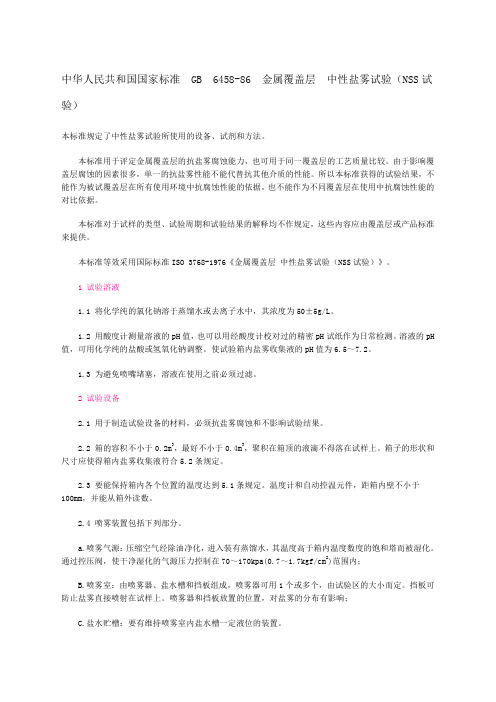
中华人民共和国国家标准GB 6458-86 金属覆盖层中性盐雾试验(NSS试验)本标准规定了中性盐雾试验所使用的设备、试剂和方法。
本标准用于评定金属覆盖层的抗盐雾腐蚀能力,也可用于同一覆盖层的工艺质量比较。
由于影响覆盖层腐蚀的因素很多,单一的抗盐雾性能不能代替抗其他介质的性能。
所以本标准获得的试验结果,不能作为被试覆盖层在所有使用环境中抗腐蚀性能的依据,也不能作为不同覆盖层在使用中抗腐蚀性能的对比依据。
本标准对于试样的类型、试验周期和试验结果的解释均不作规定,这些内容应由覆盖层或产品标准来提供。
本标准等效采用国际标准ISO 3768-1976《金属覆盖层中性盐雾试验(NSS试验)》。
1 试验溶液1.1 将化学纯的氯化钠溶于蒸馏水或去离子水中,其浓度为50±5g/L。
1.2 用酸度计测量溶液的pH值,也可以用经酸度计校对过的精密pH试纸作为日常检测。
溶液的pH 值,可用化学纯的盐酸或氢氧化钠调整。
使试验箱内盐雾收集液的pH值为6.5~7.2。
1.3 为避免喷嘴堵塞,溶液在使用之前必须过滤。
2 试验设备2.1 用于制造试验设备的材料,必须抗盐雾腐蚀和不影响试验结果。
2.2 箱的容积不小于0.2m3,最好不小于0.4m3,聚积在箱顶的液滴不得落在试样上。
箱子的形状和尺寸应使得箱内盐雾收集液符合5.2条规定。
2.3 要能保持箱内各个位置的温度达到5.1条规定。
温度计和自动控温元件,距箱内壁不小于100mm,并能从箱外读数。
2.4 喷雾装置包括下列部分。
a.喷雾气源:压缩空气经除油净化,进入装有蒸馏水,其温度高于箱内温度数度的饱和塔而被湿化。
通过控压阀,使干净湿化的气源压力控制在70~170kpa(0.7~1.7kgf/cm2)范围内;B.喷雾室:由喷雾器、盐水槽和挡板组成,喷雾器可用1个或多个,由试验区的大小而定。
挡板可防止盐雾直接喷射在试样上。
喷雾器和挡板放置的位置,对盐雾的分布有影响;C.盐水贮槽:要有维持喷雾室内盐水槽一定液位的装置。
水溶液臭味除妥氧化物灌洗用品安全数据表说明书
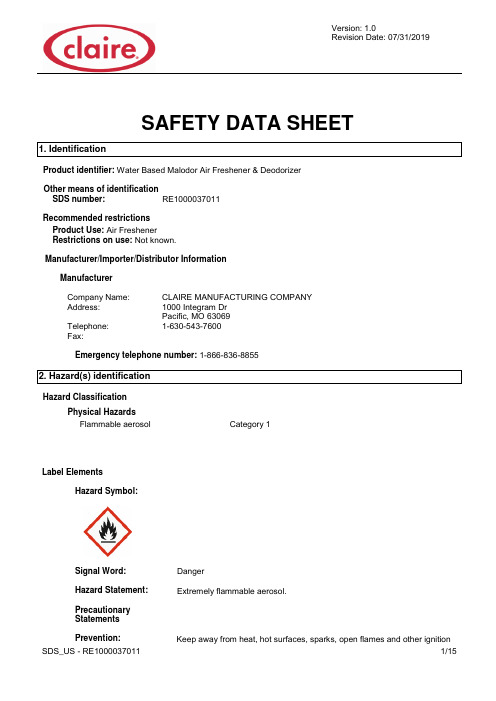
SAFETY DATA SHEET 1. IdentificationProduct identifier: Water Based Malodor Air Freshener & DeodorizerOther means of identificationSDS number: RE1000037011Recommended restrictionsProduct Use: Air FreshenerRestrictions on use:Not known.Manufacturer/Importer/Distributor InformationManufacturerCompany Name: CLAIRE MANUFACTURING COMPANYAddress: 1000 Integram DrPacific, MO 63069Telephone: 1-630-543-7600Fax:Emergency telephone number: 1-866-836-88552. Hazard(s) identificationHazard ClassificationPhysical HazardsFlammable aerosol Category 1Label ElementsHazard Symbol:Signal Word:DangerHazard Statement: Extremely flammable aerosol.PrecautionaryStatementssources. No smoking. Do not spray on an open flame or other ignitionsource. Do not pierce or burn, even after use.Storage: Protect from sunlight. Do not expose to temperatures exceeding50°C/122°F.Hazard(s) not otherwiseNone.classified (HNOC):3. Composition/information on ingredientsMixturesChemical Identity CAS number Content in percent (%)*2-Propanol67-63-0 1 - <5%Nitrogen7727-37-9 0 - <0.1%4. First-aid measuresIngestion:Rinse mouth thoroughly.Inhalation: Move to fresh air.Skin Contact:Remove contaminated clothing and wash the skin thoroughly with soap andwater after work.Eye contact:Rinse immediately with plenty of water.Most important symptoms/effects, acute and delayedSymptoms: No data available.Hazards: No data available.Indication of immediate medical attention and special treatment neededTreatment:No data available.5. Fire-fighting measuresGeneral Fire Hazards: Use water spray to keep fire-exposed containers cool. Fight fire from aprotected location. Move containers from fire area if you can do so withoutrisk.Suitable (and unsuitable) extinguishing mediaSuitable extinguishingmedia:Use fire-extinguishing media appropriate for surrounding materials.Unsuitable extinguishingmedia:Do not use water jet as an extinguisher, as this will spread the fire.Specific hazards arising from the chemical:Vapors may travel considerable distance to a source of ignition and flash back.Special protective equipment and precautions for firefighters Special fire fightingprocedures:No data available.Special protective equipment for fire-fighters: Firefighters must use standard protective equipment including flame retardant coat, helmet with face shield, gloves, rubber boots, and in enclosed spaces, SCBA.6. Accidental release measuresPersonal precautions,protective equipment and emergency procedures: Ventilate closed spaces before entering them. ELIMINATE all ignition sources (no smoking, flares, sparks or flames in immediate area). Keep upwind.Methods and material for containment and cleaning up: Stop the flow of material, if this is without risk. Absorb with sand or other inert absorbent.Notification Procedures:ELIMINATE all ignition sources (no smoking, flares, sparks or flames inimmediate area). Stop leak if you can do so without risk.Environmental Precautions: Avoid release to the environment. Prevent further leakage or spillage if safeto do so. Do not contaminate water sources or sewer. Environmentalmanager must be informed of all major spillages.7. Handling and storagePrecautions for safe handling: Keep away from heat, hot surfaces, sparks, open flames and other ignitionsources. No smoking. Do not spray on an open flame or other ignitionsource. Do not pierce or burn, even after use. Do not handle until all safetyprecautions have been read and understood. Obtain special instructionsbefore use. Use personal protective equipment as required.Conditions for safe storage, including anyincompatibilities: Pressurized container: protect from sunlight and do not expose to temperatures exceeding 50°C. Do not pierce or burn, even after use. Store locked up. Aerosol Level 18. Exposure controls/personal protectionOccupational Exposure LimitsChemical Identity Type Exposure Limit Values Source2-Propanol REL400 ppm980 mg/m3US. NIOSH: Pocket Guide to ChemicalHazards(2005)STEL400 ppm US. ACGIH Threshold Limit Values(2008)STEL500 ppm1,225 mg/m3US. OSHA Table Z-1-A (29 CFR 1910.1000)(1989)STEL500 ppm1,225 mg/m3US. Tennessee. OELs. Occupational ExposureLimits, Table Z1A(06 2008)TWA400 ppm980 mg/m3US. Tennessee. OELs. Occupational ExposureLimits, Table Z1A(06 2008)PEL400 ppm980 mg/m3US. OSHA Table Z-1 Limits for AirContaminants (29 CFR 1910.1000)(02 2006)TWA400 ppm980 mg/m3US. OSHA Table Z-1-A (29 CFR 1910.1000)(1989)STEL500 ppm1,225 mg/m3US. California Code of Regulations, Title 8,Section 5155. Airborne Contaminants(092006)AN ESL200 ppb US. Texas. Effects Screening Levels (TexasCommission on Environmental Quality)(112016)ST ESL2,000 ppb US. Texas. Effects Screening Levels (TexasCommission on Environmental Quality)(112016)STEL500 ppm1,225 mg/m3US. NIOSH: Pocket Guide to ChemicalHazards(2005)TWA200 ppm US. ACGIH Threshold Limit Values(2008)TWA PEL400 ppm980 mg/m3US. California Code of Regulations, Title 8,Section 5155. Airborne Contaminants(092006)AN ESL492 µg/m3 US. Texas. Effects Screening Levels (TexasCommission on Environmental Quality)(112016)ST ESL4,920 µg/m3 US. Texas. Effects Screening Levels (TexasCommission on Environmental Quality)(112016)1,2-Benzenedicarboxylic acid, 1,2-diethyl ester REL 5 mg/m3US. NIOSH: Pocket Guide to ChemicalHazards(2005)TWA 5 mg/m3US. ACGIH Threshold Limit Values(2008) TWA PEL 5 mg/m3US. California Code of Regulations, Title 8,Section 5155. Airborne Contaminants(092006)TWA 5 mg/m3US. OSHA Table Z-1-A (29 CFR 1910.1000)(1989)TWA 5 mg/m3US. Tennessee. OELs. Occupational ExposureLimits, Table Z1A(06 2008)ST ESL50 µg/m3 US. Texas. Effects Screening Levels (TexasCommission on Environmental Quality)(112016)AN ESL 5 µg/m3 US. Texas. Effects Screening Levels (TexasCommission on Environmental Quality)(112016)Acetic acid, pentyl ester REL100 ppm525 mg/m3US. NIOSH: Pocket Guide to ChemicalHazards(2005)TWA50 ppm US. ACGIH Threshold Limit Values(2008)STEL100 ppm US. ACGIH Threshold Limit Values(2008)STEL100 ppm532 mg/m3US. California Code of Regulations, Title 8,Section 5155. Airborne Contaminants(092006)TWA PEL50 ppm266 mg/m3US. California Code of Regulations, Title 8,Section 5155. Airborne Contaminants(092006)TWA100 ppm525 mg/m3US. Tennessee. OELs. Occupational ExposureST ESL2,700 µg/m3 US. Texas. Effects Screening Levels (TexasCommission on Environmental Quality)(112016)ST ESL500 ppb US. Texas. Effects Screening Levels (TexasCommission on Environmental Quality)(112016)AN ESL50 ppb US. Texas. Effects Screening Levels (TexasCommission on Environmental Quality)(112016)AN ESL270 µg/m3 US. Texas. Effects Screening Levels (TexasCommission on Environmental Quality)(112016)PEL100 ppm525 mg/m3US. OSHA Table Z-1 Limits for AirContaminants (29 CFR 1910.1000)(02 2006)TWA100 ppm525 mg/m3US. OSHA Table Z-1-A (29 CFR 1910.1000)(1989)TWA20 ppm US. ACGIH Threshold Limit Values(2008) Bicyclo[3.1.1]hept-2-ene,2,6,6-trimethyl-ST ESL3,500 µg/m3 US. Texas. Effects Screening Levels (TexasCommission on Environmental Quality)(112016)ST ESL630 ppb US. Texas. Effects Screening Levels (TexasCommission on Environmental Quality)(112016)AN ESL63 ppb US. Texas. Effects Screening Levels (TexasCommission on Environmental Quality)(112016)AN ESL350 µg/m3 US. Texas. Effects Screening Levels (TexasCommission on Environmental Quality)(112016)TWA10 ppm US. ACGIH Threshold Limit Values(2008) Acetic acid, phenylmethylesterTWA PEL10 ppm61 mg/m3US. California Code of Regulations, Title 8,Section 5155. Airborne Contaminants(092006)ST ESL100 ppb US. Texas. Effects Screening Levels (TexasCommission on Environmental Quality)(112016)AN ESL10 ppb US. Texas. Effects Screening Levels (TexasCommission on Environmental Quality)(112016)ST ESL610 µg/m3 US. Texas. Effects Screening Levels (TexasCommission on Environmental Quality)(112016)AN ESL61 µg/m3 US. Texas. Effects Screening Levels (TexasCommission on Environmental Quality)(112016)STEL 2 ppm US. ACGIH Threshold Limit Values(03 2018) Benzene, 1,1'-oxybis- -Vapor.TWA 1 ppm US. ACGIH Threshold Limit Values(03 2018)PEL 1 ppm7 mg/m3US. OSHA Table Z-1 Limits for AirContaminants (29 CFR 1910.1000)(02 2006)TWA PEL 1 ppm7 mg/m3US. California Code of Regulations, Title 8,Section 5155. Airborne Contaminants(092006)REL 1 ppm7 mg/m3US. NIOSH: Pocket Guide to ChemicalHazards(2005)TWA 1 ppm7 mg/m3US. OSHA Table Z-1-A (29 CFR 1910.1000)(1989)Benzene, 1,1'-oxybis-ST ESL70 µg/m3 US. Texas. Effects Screening Levels (TexasCommission on Environmental Quality)(112016)AN ESL7 µg/m3 US. Texas. Effects Screening Levels (TexasCommission on Environmental Quality)(112016)Benzene, 1,1'-oxybis- - TWA 1 ppm7 mg/m3US. Tennessee. OELs. Occupational ExposureBenzene, 1,1'-oxybis-ST ESL10 ppb US. Texas. Effects Screening Levels (TexasCommission on Environmental Quality)(112016)AN ESL 1 ppb US. Texas. Effects Screening Levels (TexasCommission on Environmental Quality)(112016)TWA 5 ppm US. ACGIH Threshold Limit Values(01 2010) 2,6-Octadienal, 3,7-dimethyl-- Inhalable fraction andvapor.2,6-Octadienal, 3,7-dimethyl-ST ESL50 ppb US. Texas. Effects Screening Levels (TexasCommission on Environmental Quality)(112016)ST ESL310 µg/m3 US. Texas. Effects Screening Levels (TexasCommission on Environmental Quality)(112016)AN ESL31 µg/m3 US. Texas. Effects Screening Levels (TexasCommission on Environmental Quality)(112016)AN ESL 5 ppb US. Texas. Effects Screening Levels (TexasCommission on Environmental Quality)(112016)Biological Limit ValuesChemical Identity Exposure Limit Values Source40 mg/l (Urine)ACGIH BEL (03 2013)2-Propanol (acetone:Sampling time: End of shift atend of work week.)Appropriate EngineeringNo data available.ControlsIndividual protection measures, such as personal protective equipmentGeneral information:Use personal protective equipment as required. Personal protectionequipment should be chosen according to the CEN standards and indiscussion with the supplier of the personal protective equipment.Eye/face protection: Wear goggles/face shield.Skin ProtectionHand Protection:No data available.Other: No data available.Respiratory Protection:In case of inadequate ventilation use suitable respirator. Seek advice fromlocal supervisor.Hygiene measures:When using do not smoke. Observe good industrial hygiene practices. Donot handle until all safety precautions have been read and understood.Obtain special instructions before use.9. Physical and chemical propertiesAppearancePhysical state:liquidForm: Spray AerosolOdor: No data available.Odor threshold: No data available.pH: No data available.Melting point/freezing point: No data available.Initial boiling point and boiling range: Estimated 100 °CFlash Point: Estimated 12.2 °CEvaporation rate: No data available.Flammability (solid, gas): No data available.Upper/lower limit on flammability or explosive limitsFlammability limit - upper (%): No data available.Flammability limit - lower (%):No data available.Explosive limit - upper (%):No data available.Explosive limit - lower (%):No data available.Vapor pressure:7,584.233 - 8,963.1845 hPa (20 °C)Vapor density:No data available.Density: No data available.Relative density:No data available.Solubility(ies)Solubility in water:No data available.Solubility (other):No data available.Partition coefficient (n-octanol/water):No data available.Auto-ignition temperature:No data available.Decomposition temperature:No data available.Viscosity:No data available.10. Stability and reactivityReactivity: No data available.Chemical Stability: Material is stable under normal conditions. Possibility of hazardousNo data available.reactions:Conditions to avoid: Avoid heat or contamination.Incompatible Materials: No data available.Hazardous DecompositionNo data available.Products:11. Toxicological informationInformation on likely routes of exposureSkin Contact: No data available.Eye contact: No data available.Ingestion: No data available.Symptoms related to the physical, chemical and toxicological characteristics Inhalation: No data available.Skin Contact: No data available.Eye contact: No data available.Ingestion: No data available.Information on toxicological effectsAcute toxicity (list all possible routes of exposure)OralProduct: Not classified for acute toxicity based on available data.Specified substance(s):2-Propanol LD 50 (Rat):5.84 g/kgDermalProduct: Not classified for acute toxicity based on available data.Specified substance(s):2-Propanol LD 50:> 2,000 mg/kgInhalationProduct: Not classified for acute toxicity based on available data.Specified substance(s):2-Propanol LC 50:> 5 mg/lLC 50:> 20 mg/lRepeated dose toxicityProduct: No data available.Specified substance(s):2-Propanol NOAEL (Rat, Inhalation, >= 104 Weeks): 5,000 ppm(m) InhalationExperimental result, Key studySkin Corrosion/IrritationProduct: No data available.Specified substance(s):2-Propanol in vivo (Rabbit): Not Classified Experimental result, Key study Serious Eye Damage/Eye IrritationProduct: No data available.Specified substance(s):2-Propanol Rabbit, 1 d: Irritating.Respiratory or Skin SensitizationProduct: No data available.Specified substance(s):2-Propanol Skin sensitization:, in vivo (Guinea pig): Non sensitising CarcinogenicityProduct: No data available.IARC Monographs on the Evaluation of Carcinogenic Risks to Humans:No carcinogenic components identifiedUS. National Toxicology Program (NTP) Report on Carcinogens:No carcinogenic components identifiedUS. OSHA Specifically Regulated Substances (29 CFR 1910.1001-1050):No carcinogenic components identifiedGerm Cell MutagenicityIn vitroProduct: No data available.In vivoProduct: No data available.Reproductive toxicityProduct: No data available.Specific Target Organ Toxicity - Single ExposureProduct: No data available.Specific Target Organ Toxicity - Repeated ExposureProduct: No data available.Aspiration HazardProduct: No data available.Other effects: No data available.12. Ecological informationEcotoxicity:Acute hazards to the aquatic environment:FishProduct: No data available.Specified substance(s):2-Propanol LC 50 (Pimephales promelas, 96 h): 9,640 mg/l Experimental result, KeystudyAquatic InvertebratesProduct: No data available.Specified substance(s):2-Propanol LC 50 (Daphnia magna, 24 h): > 10,000 mg/l Experimental result, Key study Chronic hazards to the aquatic environment:FishProduct: No data available.Aquatic InvertebratesProduct: No data available.Toxicity to Aquatic PlantsProduct: No data available.Persistence and DegradabilityBiodegradationProduct: No data available.Specified substance(s):2-Propanol53 % (5 d) Detected in water. Experimental result, Key study BOD/COD RatioProduct: No data available.Bioaccumulative potentialBioconcentration Factor (BCF)Product: No data available.Partition Coefficient n-octanol / water (log Kow)Product: No data available.Mobility in soil: No data available.Known or predicted distribution to environmental compartments2-Propanol No data available.Nitrogen No data available.Other adverse effects: No data available.13. Disposal considerationsDisposal instructions: Discharge, treatment, or disposal may be subject to national, state, or locallaws.Contaminated Packaging: No data available.14. Transport informationDOTUN Number: UN 1950UN Proper Shipping Name: Aerosols, flammableTransport Hazard Class(es)Class: 2.1Label(s): –Packing Group: IIMarine Pollutant: NoEnvironmental Hazards: NoMarine Pollutant NoSpecial precautions for user: Not regulated.IMDGUN Number: UN 1950UN Proper Shipping Name: Aerosols, flammableTransport Hazard Class(es)Class: 2Label(s): –EmS No.:Packing Group: –Environmental Hazards: NoMarine Pollutant NoSpecial precautions for user: Not regulated.IATAUN Number: UN 1950Proper Shipping Name: Aerosols, flammableTransport Hazard Class(es):Class: 2.1Label(s): –Packing Group: –Environmental Hazards: NoMarine Pollutant NoSpecial precautions for user: Not regulated.15. Regulatory informationUS Federal RegulationsTSCA Section 12(b) Export Notification (40 CFR 707, Subpt. D)US. OSHA Specifically Regulated Substances (29 CFR 1910.1001-1050) None present or none present in regulated quantities.CERCLA Hazardous Substance List (40 CFR 302.4):Chemical Identity Reportable quantity2-Propanol lbs. 100lbs. 10001,2-Benzenedicarboxylicacid, 1,2-diethyl esterAcetic acid, pentyl ester lbs. 5000lbs. 100Bicyclo[3.1.1]hept-2-ene,2,6,6-trimethyl-Superfund Amendments and Reauthorization Act of 1986 (SARA) Hazard categoriesFire HazardFlammable aerosolSARA 302 Extremely Hazardous SubstanceNone present or none present in regulated quantities.SARA 304 Emergency Release NotificationChemical Identity Reportable quantity2-Propanol lbs. 100lbs. 10001,2-Benzenedicarboxylicacid, 1,2-diethyl esterAcetic acid, pentyl ester lbs. 5000lbs. 100Bicyclo[3.1.1]hept-2-ene,2,6,6-trimethyl-SARA 311/312 Hazardous ChemicalChemical Identity Threshold Planning Quantity 2-Propanol10000lbs1,2-Benzenedicarboxylicacid, 1,2-diethyl ester10000lbsAcetic acid, pentyl ester10000lbsBicyclo[3.1.1]hept-2-ene,2,6,6-trimethyl-10000lbsAcetic acid, phenylmethylester10000lbsBenzene, 1,1'-oxybis-10000lbs2,6-Octadienal, 3,7-dimethyl-10000lbsNitrogen10000lbsSARA 313 (TRI Reporting)Chemical Identity Reportingthreshold forother usersReporting threshold formanufacturing andprocessing2-Propanol lbs lbs.Clean Air Act (CAA) Section 112(r) Accidental Release Prevention (40 CFR 68.130):Clean Water Act Section 311 Hazardous Substances (40 CFR 117.3)US State RegulationsUS. California Proposition 65This product contains chemical(s) known to the State of California to cause cancer and/or to cause birth defects or other reproductive harm.Methanone, diphenyl-Carcinogenic. 07 2012US. New Jersey Worker and Community Right-to-Know ActChemical Identity2-PropanolUS. Massachusetts RTK - Substance ListNo ingredient regulated by MA Right-to-Know Law present.US. Pennsylvania RTK - Hazardous SubstancesChemical Identity2-PropanolUS. Rhode Island RTKNo ingredient regulated by RI Right-to-Know Law present.International regulationsMontreal protocolNot applicableStockholm conventionNot applicableRotterdam conventionNot applicableKyoto protocolNot applicableInventory Status:Australia AICS: Not in compliance with the inventory.EINECS, ELINCS or NLP: Not in compliance with the inventory.Japan (ENCS) List: Not in compliance with the inventory.China Inv. Existing Chemical Substances: Not in compliance with the inventory.Korea Existing Chemicals Inv. (KECI): Not in compliance with the inventory.Canada NDSL Inventory: Not in compliance with the inventory.Philippines PICCS: Not in compliance with the inventory.New Zealand Inventory of Chemicals: Not in compliance with the inventory.Japan ISHL Listing: Not in compliance with the inventory.Japan Pharmacopoeia Listing: Not in compliance with the inventory.Mexico INSQ: Not in compliance with the inventory.Ontario Inventory: Not in compliance with the inventory.Taiwan Chemical Substance Inventory: Not in compliance with the inventory.Canada DSL Inventory List: On or in compliance with the inventory US TSCA Inventory: On or in compliance with the inventory 16.Other information, including date of preparation or last revisionIssue Date: 07/31/2019Revision Information:No data available.Version #: 1.0Further Information: No data available.Disclaimer: This information is provided without warranty. The information is believed tobe correct. This information should be used to make an independentdetermination of the methods to safeguard workers and the environment.。
叔丁基过氧化氢工业标准
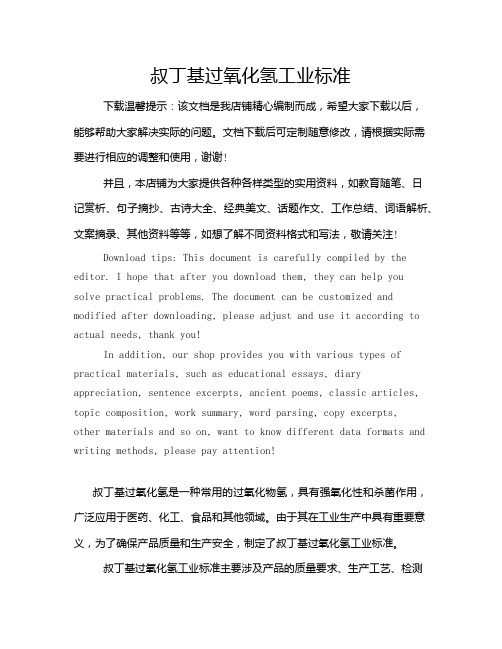
叔丁基过氧化氢工业标准下载温馨提示:该文档是我店铺精心编制而成,希望大家下载以后,能够帮助大家解决实际的问题。
文档下载后可定制随意修改,请根据实际需要进行相应的调整和使用,谢谢!并且,本店铺为大家提供各种各样类型的实用资料,如教育随笔、日记赏析、句子摘抄、古诗大全、经典美文、话题作文、工作总结、词语解析、文案摘录、其他资料等等,如想了解不同资料格式和写法,敬请关注!Download tips: This document is carefully compiled by the editor. I hope that after you download them, they can help yousolve practical problems. The document can be customized and modified after downloading, please adjust and use it according to actual needs, thank you!In addition, our shop provides you with various types of practical materials, such as educational essays, diary appreciation, sentence excerpts, ancient poems, classic articles, topic composition, work summary, word parsing, copy excerpts,other materials and so on, want to know different data formats and writing methods, please pay attention!叔丁基过氧化氢是一种常用的过氧化物氢,具有强氧化性和杀菌作用,广泛应用于医药、化工、食品和其他领域。
季按盐类消毒剂卫生标准说明书

澳 型 季 按盐 quaternary ammonium bromide 由 C,_CI。的脂肪链 (单链或双链 )、甲基 (或节 基 、乙 基 节基 )组成 的澳化季按盐 。
3.4
清 洁 对 象 clean object
经过清洗或者仅存在极少 量 有 机物污染 的被消毒对象 。
3.5
污 染 对 象 dirty object 未经过清洗或者存在较 多 有 机 物污染的被消毒对象 。
对于与食品接触物品的消毒,使用消毒液的季按盐含量不宜超过 1 000 mg/L,消毒后必 须用 水 充 分冲洗后方可接触食品。 7.2 多孔表面的消毒
清洁对象:浸泡消毒 , 用 季 按盐含量为400 mg/L-1 200 mg/L的消毒溶液作用 5 min-20 min;喷 雾消毒,用季按盐含量为 1 000 mg/L-1 200 mg/L的消毒溶液作用 5 min-20 min.
GB 14930.2 食品工具、设备用洗涤消毒剂卫生标准
中华人民共和国卫生部 消 毒技术规范 2002年版 中华人 民共和 国卫生部 消毒产品标签说明书管理规 范 2 005年版
术语和定义
下列术语和 定 义 适 用于本标准 。
3.1
季 按 盐 类消毒剂 quaternary ammonium disinfectant 以季钱盐为主要化学成分的消毒剂 ,本标准指以氯型季 按 盐 、 澳型季按盐为主要杀菌有效成分的消
5.4 杀灭微生物指标
消毒对象和使用剂 量 按 产 品说明书的要求 ,按卫生部《消毒技术规范 》(2002年版)中的定量杀菌试
验方法进行试验,其杀菌效果应符合表 2要求。
2
GB 26369- 2010
表 2 杀灭微生物指标
2016年10月最新版工业产品生产许可证实施细则73-危险化学品化学试剂
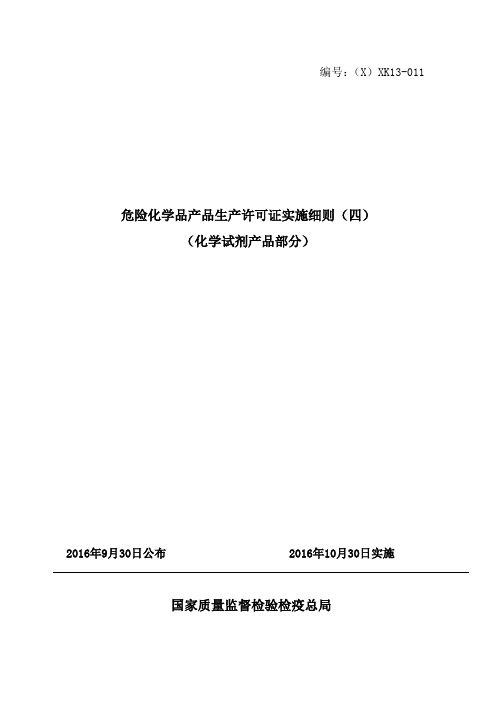
编号:(X)XK13-011危险化学品产品生产许可证实施细则(四)(化学试剂产品部分)2016年9月30日公布 2016年10月30日实施国家质量监督检验检疫总局目录第一章总则 (1)第二章发证产品及标准 (1)第三章企业申请生产许可证的基本条件和资料 (9)第四章企业实地核查 (22)第五章产品检验 (23)第六章证书许可范围 (35)第七章附则 (36)附件1企业核查时准备书面材料清单 (38)附件1-1企业生产危险化学品化学试剂产品主要工艺流程图 (38)附件1-2企业生产危险化学品化学试剂产品生产设施和检验设施表 (40)附件1-3企业生产危险化学品化学试剂产品生产场所示意图 (41)附件1-4企业生产危险化学品化学试剂产品生产设备表 (42)附件1-5企业生产危险化学品化学试剂产品检验设备表 (43)附件1-6企业生产危险化学品化学试剂产品重要原材料明细表 (44)附件1-7关键岗位专业技术人员表 (45)附件1-8产品技术文件和工艺文件清单 (46)附件2危险化学品化学试剂产品生产许可证企业实地核查办法 (47)附件3企业实地核查不符合和建议改进项汇总表 (55)附件4生产许可证企业实地核查报告 (56)附件5检验报告格式 (57)附件6本实施细则与旧版细则主要内容对比表 (61)危险化学品产品生产许可证实施细则(化学试剂产品)第一章总则第一条为了做好危险化学品化学试剂产品生产许可证审查工作,依据《危险化学品安全管理条例》、《中华人民共和国工业产品生产许可证管理条例》、《中华人民共和国工业产品生产许可证管理条例实施办法》、《工业产品生产许可证实施通则》(以下简称通则)等规定,制定本工业产品生产许可证实施细则(以下简称细则)。
第二条本细则适用于危险化学品化学试剂产品生产许可的实地核查、产品检验等工作,应与通则一并使用。
第三条危险化学品化学试剂产品由各省、自治区、直辖市质量技术监督局(市场监督管理部门)发证。
JBT6047-1992热处理盐浴有害固体废物无害化处理方法.
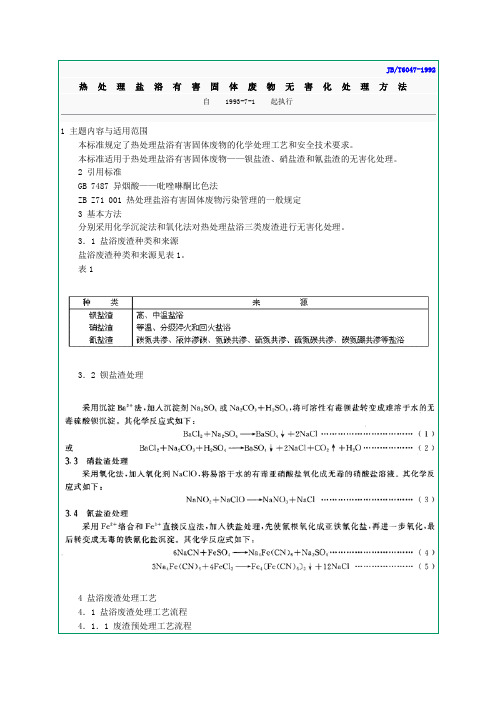
分别采用化学沉淀法和氧化法对热处理盐浴三类废渣进行无害化处理。
3.1盐浴废渣种类和来源
盐浴废渣种类和来源见表1。
表1
3.2钡盐渣处理
4盐浴废渣处理工艺
4.1盐浴废渣处理工艺流程
4.1.1废渣预处理工艺流程
废渣预处理工艺流程见图1。
图1
4.1.2钡盐渣浸出液处理工艺流程
钡盐渣浸出液处.理工艺流程见图2。
JB/T6047-1992
热处理盐浴有害固体废物无害化处理方法
自1993-7-1起执行
1主题内容与适用范围
本标准规定了热处理盐浴有害固体废物的化学处理工艺和安全技术要求。
本标准适用于热处理盐浴有害固体废物——钡盐渣、硝盐渣和氰盐渣的无害化处理。
2引用标准
GB 7487异烟酸——吡唑啉酮比色法
ZB Z71 001热处理盐浴有害固体废物污染管理的一般规定
附加说明:
本标准由机械电子工业部机械工业环境保护技术研究所提出并归口。
本标准由机械电子工业部机械工业环境保护技术研究所负责起草。
本标准主要起草人张文莲、伍昕忠。
发布单位:
中华人民共和国机械电子工业部
提出单位:
机械电子工业部机械工业环境保护技术研究所
起草单位:
机械电子工业部机械工业环境保护技术研究所
批准单位:
5安全技术要求
5.1破碎及处理废渣时(特别是氰盐渣),必须在有通风管道、排气、吸尘、湿法贮存装置的厂房或车间进行。
5.2处理设备或容器必须加盖,防渗漏,防腐蚀,严防毒物流失。操作人员要严格注意安全防护。
6有害物质分析
钡盐及亚硝酸盐分析方法,按ZB Z71 001附录A(参考件)规定进行。
氰化物分析方法,按GB 7487规定进行。
己二胺盐酸盐分析方案
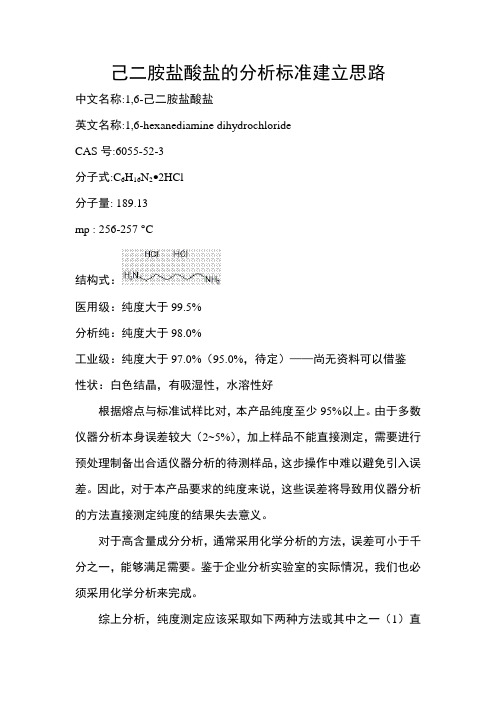
己二胺盐酸盐的分析标准建立思路中文名称:1,6-己二胺盐酸盐英文名称:1,6-hexanediamine dihydrochlorideCAS号:6055-52-3分子式:C6H16N2 2HCl分子量: 189.13mp : 256-257 °C结构式:医用级:纯度大于99.5%分析纯:纯度大于98.0%工业级:纯度大于97.0%(95.0%,待定)——尚无资料可以借鉴性状:白色结晶,有吸湿性,水溶性好根据熔点与标准试样比对,本产品纯度至少95%以上。
由于多数仪器分析本身误差较大(2~5%),加上样品不能直接测定,需要进行预处理制备出合适仪器分析的待测样品,这步操作中难以避免引入误差。
因此,对于本产品要求的纯度来说,这些误差将导致用仪器分析的方法直接测定纯度的结果失去意义。
对于高含量成分分析,通常采用化学分析的方法,误差可小于千分之一,能够满足需要。
鉴于企业分析实验室的实际情况,我们也必须采用化学分析来完成。
综上分析,纯度测定应该采取如下两种方法或其中之一(1)直接纯度测定采用滴定完成;(2)测量所有非主成分含量,差减得到纯度指标。
详细说明:(1)采用非水滴定(尚需验证)。
冰醋酸做溶剂,加入醋酸汞消除盐酸干扰,高氯酸滴定。
(2)测量所有杂质含量,根据本生产流程,初步设定如下待检指标:性状:白色结晶粉末纯度:>98%挥发份:<(105°C,2小时)水溶残渣:<(蒸馏水,离心)灰份:<(550°C,瓷坩埚,灼烧衡重,必要时用X射线荧光检测各元素种类和含量或ICP检测Ca元素含量)Ca:<(EDTA滴定,加标回收测试方法可靠性,若灰份极少,则此检测方法不可行)己二酸:(重结晶应该不再有残留,红外未检出——待定)色度:(比色卡)酸碱度:7±0.2(蒸馏水,酸度计)非水滴定的纯度测定中遇到的问题自制对照品,重结晶10次多次萃取合并,可以认为100%测定基团含量,例如银量法测定氯离子,折算色谱,对照,纯度98-102%己二酸脱色不好,絮状沉淀,工艺水,20mg/l Fe含量超标,色度不合格聚六亚甲基双胍盐酸盐(PHMB)的合成:其合成路线是由己二胺和双氰胺的铜盐或锌盐在60℃加热反应,通二氧化氯使pH值由11降至6.8-7,冷却过滤,先制得已亚甲基二胺的二氰酸盐,再用已二胺和36%的盐酸处理,然后加热至150-155℃,搅拌反应4小时,即得产品。
熔盐氯化尾气处理系统分析
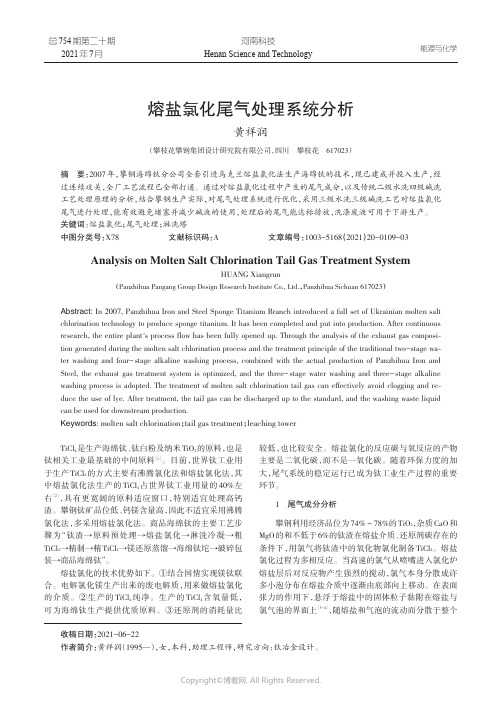
总754期第二十期2021年7月河南科技Henan Science and Technology熔盐氯化尾气处理系统分析黄祥润(攀枝花攀钢集团设计研究院有限公司,四川攀枝花617023)摘要:2007年,攀钢海绵钛分公司全套引进乌克兰熔盐氯化法生产海绵钛的技术,现已建成并投入生产,经过连续攻关,全厂工艺流程已全部打通。
通过对熔盐氯化过程中产生的尾气成分,以及传统二级水洗四级碱洗工艺处理原理的分析,结合攀钢生产实际,对尾气处理系统进行优化,采用三级水洗三级碱洗工艺对熔盐氯化尾气进行处理,能有效避免堵塞并减少碱液的使用,处理后的尾气能达标排放,洗涤废液可用于下游生产。
关键词:熔盐氯化;尾气处理;淋洗塔中图分类号:X78文献标识码:A文章编号:1003-5168(2021)20-0109-03 Analysis on Molten Salt Chlorination Tail Gas Treatment SystemHUANG Xiangrun(Panzhihua Pangang Group Design Research Institute Co.,Ltd.,Panzhihua Sichuan617023)Abstract:In2007,Panzhihua Iron and Steel Sponge Titanium Branch introduced a full set of Ukrainian molten salt chlorination technology to produce sponge titanium.It has been completed and put into production.After continuous research,the entire plant's process flow has been fully opened up.Through the analysis of the exhaust gas composi⁃tion generated during the molten salt chlorination process and the treatment principle of the traditional two-stage wa⁃ter washing and four-stage alkaline washing process,combined with the actual production of Panzhihua Iron and Steel,the exhaust gas treatment system is optimized,and the three-stage water washing and three-stage alkaline washing process is adopted.The treatment of molten salt chlorination tail gas can effectively avoid clogging and re⁃duce the use of lye.After treatment,the tail gas can be discharged up to the standard,and the washing waste liquid can be used for downstream production.Keywords:molten salt chlorination;tail gas treatment;leaching towerTiCl4是生产海绵钛、钛白粉及纳米TiO2的原料,也是钛相关工业最基础的中间原料[1]。
53项行业标准外文版名称及主要内容等一览表

本文件适用于银中铜、铋、铁、铅、锑、钯、硒和碲量的测定。
翻译已有标准
英语
自发布之日起实施
20
YS/T 1460-2021
粗氢氧化镍钴
Crude nickel cobalt hydroxide
本文件规定了粗氢氧化镍钴的技术要求、试验方法、检验规则和标志、包装、运输、贮存及随行文件和订货单内容。
翻译已有标准
英语
自发布之日起实施
5
HG/T 3126-2017
搪玻璃蒸馏容器
Glass-lined steel vessel for distillation
本文件规定了搪玻璃蒸馏容器的型式、基本参数、主要尺寸、要求、铭牌、出厂文件及包装、运输。
本文件适用于容器内设计压力小于等于0.6MPa,夹套内设计压力小于等于0.6MPa,容器及夹套内设计温度高于-20℃~200℃,公称容积300L~8000L的搪玻璃蒸馏容器。
26
JC/T 2052-2020
辊压法无石棉纤维垫片材料
Compressed non-asbestos fibre gasket materials
本文件规定了辊压法无石棉纤维垫片材料的分类和标记、要求、试验方法、检验规则以及标志、包装、运输和贮存。
本文件适用于以不含有石棉成分的纤维为主要增强材料、以弹性体为粘合剂和辅助增强材料,再添加其他填料,经辊压制成的用于制作密封垫片的板材。用这种板材制成的密封垫片也可参照采用。
8
HG/T 4905-2016
网球鞋
Tennis shoes
本文件规定了网球鞋的要求,试验方法,检验规则以及标志、包装、运输和贮存。
jbt60481

J 36JB/T 6048-1992盐浴热处理1992-05-05 发布1993-07-01 实施中华人民共和国机械电子工业部发布11 主题内容与适用范围本标准规定了盐浴热处理的设备要求、盐浴要求、工艺操作及安全与环境保护等。
本标准适用于金属工件在中性盐浴或硝盐浴中的加热和冷却。
2引用标准GB 223.1钢铁及合金中的碳量分析GB 1298碳素工具钢 技术条件JB 3814钢的正火与退火处理JB 3877钢的淬火回火处理JB 4390高、中温热处理盐浴校正剂JB 4406热处理安全技术的一般规定JB 5266间接电阻炉 第12部分 RY 系列电热浴炉JB/T 5093热处理车间气体中有害物质的限值ZB J36 007热处理用盐ZB J71 001热处理盐浴有害固体废物污染控制的一般规定QJ/Z 124变形铝合金的热处理3 术语3. 1 中性盐浴中性盐(如碱金属与碱土金属氯化盐、碱金属碳酸盐或其混合盐)加热熔化后形成的液态介质。
3. 2 硝盐浴硝酸盐、亚硝酸盐或其混合盐加热熔化后形成的液态介质。
3. 3 高温盐浴在950℃以上使用的盐浴。
3. 4 中温盐浴在650~950℃之间使用的盐浴。
3. 5 低温盐浴在650℃以下使用的盐浴。
3. 6 盐浴调整通过盐浴校正、除渣及添加新盐等操作,使盐浴具有符合工艺要求的性能。
3. 7 盐浴校正向盐浴内加入校正剂,以除去盐浴中氧化物,防止或减少工件氧化、脱碳的操作。
3. 8 箔片脱碳率箔片加热前原始含碳量和加热后剩余含碳量的差值与箔片加热前原始含碳量之比的百分数。
机械电子工业部 1992-05-05 批准中华人民共和国机械行业标准盐 浴 热 处 理JB/T 6048-19921993-07-01 实施。
- 1、下载文档前请自行甄别文档内容的完整性,平台不提供额外的编辑、内容补充、找答案等附加服务。
- 2、"仅部分预览"的文档,不可在线预览部分如存在完整性等问题,可反馈申请退款(可完整预览的文档不适用该条件!)。
- 3、如文档侵犯您的权益,请联系客服反馈,我们会尽快为您处理(人工客服工作时间:9:00-18:30)。
1、 Subject Matter and Scope This standard specifies the salt bath heat treating equipment requirements, bath requirements, process operation and safety, and environmental protection. This standard applies to metal parts for heating and cooling in a neutral salt bath or nitrate bath. 2、Reference Standard GB 223.1 Analysis of the carbon content in Steel and Alloys GB 1298 Carbon tool steel Technical conditions
QJ / Z 124 Wrought aluminum alloy heat treatment 3、 Terms 3.1 neutral salt baths Neutral salt (e.g., alkali metal salts and alkaline earth metal chloride, an alkali metal carbonate salt or mixtures) after heating a liquid medium formed by melting. 3.2 nitrate bath Nitrate, nitrite or mixtures after heating a liquid medium formed by melting 3.3 high-temperature salt bath Above 950 ℃ bath use. 3.4 medium temperature salt baths The salt bath temperature between 650℃ and 950℃ 3.5 Low Temperature salt baths Below 650 ℃ used 3.6 Salt baths adjustment By Salt baths correction, clean and adding a new salt slag or other operations that meet the technical requirements of the salt bath with performance. 3.7 Salt baths correction Correction solvent was added into the salt bath to remove the oxide, the operation of prevent or reduce oxidation of the parburization rate The ratio of the difference between original carbon content of the sample and residual carbon content and original carbon content of the sample 4 、Commonly used metal materials Carbon tool steel, alloy tool steel, high speed tool steel, high-quality carbon steel, alloy structural steel, spring steel, chromium bearing steel, Martensite stainless steel, deformation aluminum and so on. Technical condition of the material should comply with the relevant standards. 5、 Equipment 5.1 Salt bath furnace 5.1.1 According to the conditions, salt bath furnace heated by electric or fuel. 5.1.2 Electrical heating salt bath furnace shall comply with the relevant provisions of JB 5266. 5.1.3 Salt bath furnace heating zone effective insulation accuracy should meet the technical requirements, generally should not exceed ± 15 ℃ (for steel heating) or ± 5 ℃ (suitable for heating deformation of aluminum alloy). 5.1.4 Bipolar silver electrodes salt bath furnace, recommended the use of embedded electrode structure, melting
JB 3814 Normalizing and annealing processing for steel JB 3877 Quenched and tempered processing for steel JB 4390 Salt bath calibrator for high temperature and medium temperature heat treatment JB 4406 General requirements of safety technology during heat treatment JB 5266 Indirect resistance furnaces furnace JB / T 5093 Limit of Harmful substances in the gas of Heat treatment shop ZB J36 007 Heat treatment salt ZB J71 001 General provisions of controlling hazardous solid waste pollution of salt bath heat treatment Part 12 RY series electric bath
